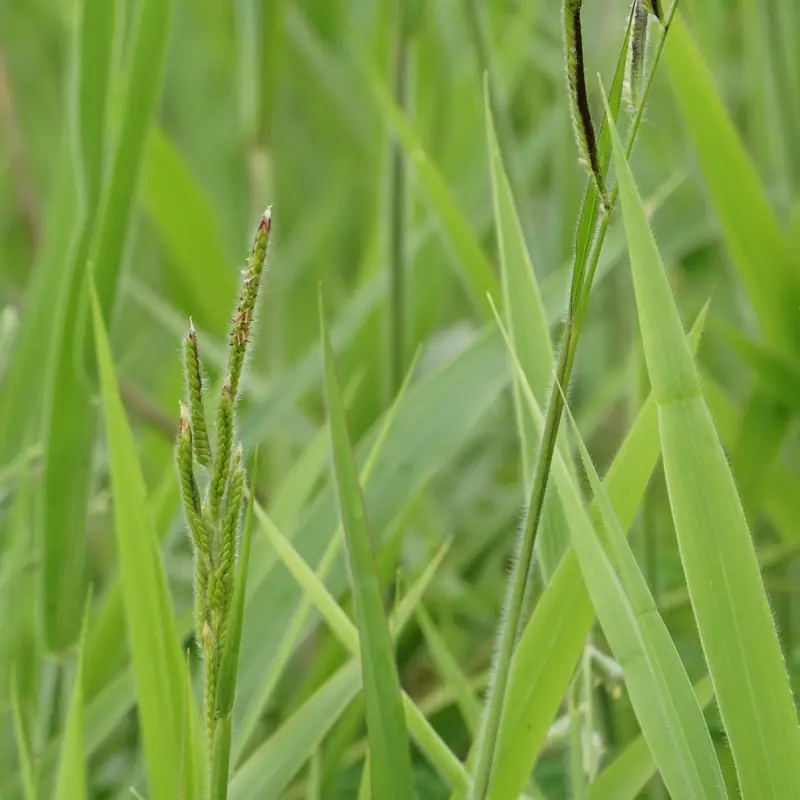
April 26, 2021 | Lawn Care Management | Kylie Kelty
Warm-season grasses are popular choices for those of us who live in the south. Unfortunately, for regions like Louisville, where we can have both cool and warm-season turfgrass, the warm-season grasses can become a nuisance. If left unchecked, they can ruin the look of our lawns and quickly overtake the cool-season grasses we do want, like tall fescue. Learn how to identify five of the most common uncontrollable grasses plaguing lawns in Kentuckiana and how a few key yard maintenance tricks can keep these weeds out for good!
A popular choice of many homeowners further south, this grass can quickly spread and crowd out cool-season turfgrass. This warm-season perennial spreads aggressively through both stolons and rhizomes, which makes it one of the toughest grasses to remove once it’s established in your lawn. Bermudagrass thrives in the warmest months when cool-season varieties like tall fescue are winding down their growing period. Consequently, Bermudagrass will push out the tall fescue, and you may not even realize it’s taken over until it starts to die off in the fall.
Often mistaken for crabgrass, Bermudagrass has short leaf blades with dead leaf sheaths at each joint. If left undisturbed, it will sprout small yellow flower clusters. However, unlike crabgrass, it has strong rhizomes. So, if you remove a clump of weeds that you believe is crabgrass, take a look and see if there’s a robust root system beneath the surface. If so, you may be dealing with Bermudagrass. Like many warm-season grasses, another identifying feature is its penchant for popping up in areas of the lawn that receive full sun – usually after you’ve mowed. As fall approaches, it will go dormant and turn brown or purple in hue.
Another warm-season perennial. Like Bermudagrass, they prefer full sun and will happily root in lawns of cool-season grasses.
Blades of Dallisgrass are coarse in texture with hairs along the leaf edge. It is similar in appearance to both Bermudagrass and crabgrass, but its tufts are more rounded in shape. And the seed tufts at the end tend to be longer and fingerlike than other unwanted weed grasses.
Paspalum is a perennial weed that sometimes gets mistaken for Dallisgrass. In our area, we see two types: field Paspalum and thin(bull) Paspalum.
While it’s very similar in appearance to Dallisgrass, the leaves of thin(bull) Paspalum and glossier and shinier than Dallisgrass. Field Paspalum has wider blades than most grasses – up to 10 mm. It sticks out in summer and has either dark green or yellow foliage.
Nimblewill is another warm-season perennial that plagues our lawns. It is blue-green in color and forms patches similar to bentgrass or bermudagrass. You may notice it as small patches that grow as the season progresses.
Nimblewill leaves are coarse-textured and may appear as brown patches during the colder months. You may also notice spike-like panicles, which are clusters of flowers, in late summer through early fall. Like many of the undesired grasses, it will form in mat-like patches.
Johnsongrass is a perennial weed that reproduces quickly and can reach considerable height. Once established in a lawn, it can be tricky to remove because it reproduces through both seeds and a strong root system.
Look for coarse, vertically-growing grass with long flat blades. You may also notice a seedhead with hints of purple. Another defining characteristic is that johnsongrass seedlings do not have hair on the lower leaf surface.
Part of a good lawn care routine is mowing, but you should make sure to set your mower to the correct height. Keep your mower height between 2.5 and 3 inches. It’s tempting to set it to the lowest setting and whack the weeds while you cut the grass, but the shorter your grass, the easier it is for weeds to germinate. Most need direct sunlight, and by cutting the lawn short, you’re giving it to them.
Nothing keeps out unwanted weeds and grasses more than a healthy lawn. When grass is nourished and kept at the correct height, weeds won’t have a chance to germinate.
A lawn care technician will be able to quickly identify which weeds or grasses are lurking in your lawn. From there, they can employ post-emergent selective herbicide. This is industry lingo for a weed killer that is designed to only target weeds – your turfgrass will be completely safe! A lawn care professional will also apply a pre-emergent herbicide in spring to help guard against future problems.
Managing any warm-season weed is challenging. Why not let the experts at Farison Lawn Care handle things? We offer weed control services to Louisville, KY, and southern Indiana. If you’re tired of losing the war on weeds, sign up for our premium lawn care program. We’ll keep your lawn healthy and thriving, so encroaching weeds and unwanted grasses don’t stand a chance! Give us a call today at (502) 245-9422 or leave us a message online. If you’d like to read more about lawn care best practices and weed prevention, be sure to check out our monthly blog! And for the latest deals and service offerings, follow on Facebook, Twitter, and Pinterest!
love what we do?